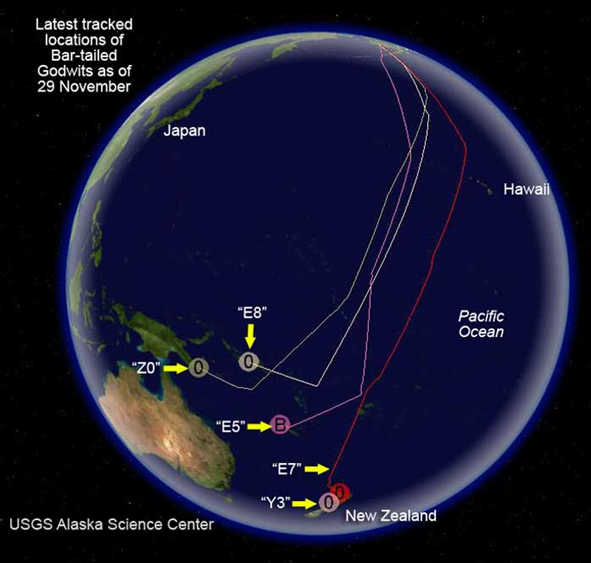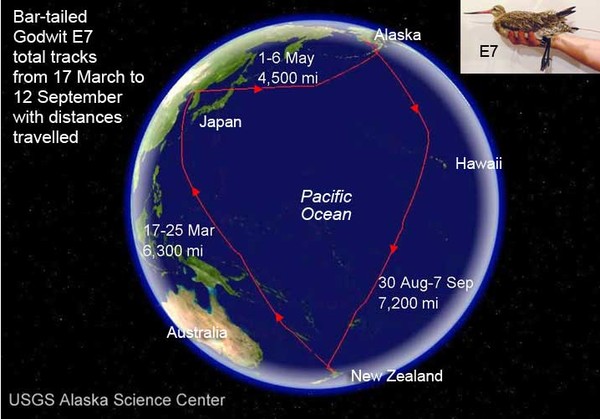Farewell to the godwits
Christchurch will hold a send-off on Sunday evening for the champions
of bird migration, the bar-tailed godwits, wishing them the best on
their hazardous journey back to Alaska.
Residents, birdwatchers and wildlife enthusiasts will gather at the
Southshore Spit to farewell some 2000 godwits on the first leg of
their two-stage journey home. It will be a quiet send-off, says Paul
Kean of the Council's Event team, adding that thoughts of the danger
the wee birds face will underpin the send-off event.
"We take care not to disturb the birds as they need to conserve all
their strength. The godwits feed, rest and conserve their energy
during their stay with us, so it is important to leave them
undisturbed and unstressed," says Mr Kean.
There will also be an element of celebration - this is the first time
in several years that Christchurch has hosted so many godwits.
Currently, about 2465 Godwits are preparing for departure on local
estuaries. Some 2006 Godwits were counted on the Avon-Heathcote
Estuary in Christchurch, with another 85 at Brooklands Lagoon and 374
at the top end of Lyttelton Harbour.
"These are the highest numbers recorded locally for several years and
it is hoped that the recent downward trend in numbers might
stabilise," says Council ranger and bird expert, Andrew Crossland. The
higher numbers offer hope for the godwits which have been steadily
losing habitats in the Korean and Chinese coasts
The bar-tailed godwit (Limosa lapponica baueri) - or kuaka in the
Maori language - stops off in Asia to rebuild strength before tackling
the last leg to Alaska. Each of the mature fliers would have stored up
to 500 grams of fat to fuel the non-stop, 10,000 km journey which is
completed within eight days. The direct flights are some of the
longest migratory bird flights ever recorded - and some of the
toughest.
The scientific community deems the dwindling population of godwits as
a Species of High Concern and Christchurch has made the godwits its
own by designating them the harbingers of spring, and ensuring a safe
environment for them at the Avon-Heathcote Estuary.
The Christ Church Cathedral bells peal for 30 minutes to announce the
arrival of the visitors in September after a 11,000 km non-stop flight
and the Christchurch City Council rangers and the Avon-Heathcote
Estuary Ihutai Trust puts together a farewell event in March.
The godwits farewell will be on site at the Southshore Spit from 6pm
on Sunday 9th March (at the end of Rocking Horse Road- you can catch a
Route 5 bus). Please no dogs.
Maps available at
http://alaska.usgs.gov/science/biology/shorebirds/barg_updates.html
Additional information
This year, some 2006 Godwits have been counted on the Avon-Heathcote
Estuary in Christchurch, with another 85 at Brooklands Lagoon and 374
at the top end of Lyttelton Harbour. These are the highest numbers
recorded locally for several years and it is hoped that the recent
downward trend in numbers might stabilise, although this is probably
unlikely given the huge amount of habitat that Godwits and other
migratory wading birds have lost on the Korean and Chinese coasts.
Once back in the Arctic the Godwits will quickly find a mate and begin
breeding. Because the Arctic has almost 24 hours of daylight for much
of the breeding season, the Godwits are able to pack a lot of living
into a short window of time. Their preferred breeding habitat is
marshy tundra, particularly within open bogs and in swamps with
scattered, stunted trees. To claim a territory and attract a mate,
the male Godwit performs an aerial "sky dance" , which involves
intricate aerobatic display flights and a short song. Parts of this
display are sometimes seen on New Zealand estuaries just prior to
migration.
The nest is constructed on the ground and consists of a shallow bowl
lined with a few pieces of dry vegetation and sticks. Three to four
eggs are laid and are incubated by both parents until hatching at
three weeks. The chicks can walk about, swim and feed themselves from
birth but they stay close to the adults until they can fly at four
weeks of age. Adults depart the breeding grounds earlier than the
young and often use separate staging areas on the Alaskan coast prior
to migration back to New Zealand. It seems that the adults and
juvenile Godwits largely migrate separately so it seems it is instinct
alone that brings the young Godwits to NZ on their first migration.
New Zealand hosts 70,000 godwits each summer, but it used to be
wintering home to 100,000. It is the same throughout the East Asian
and Australasian flyways, where up to 85% of the shorebird populations
are declining.


